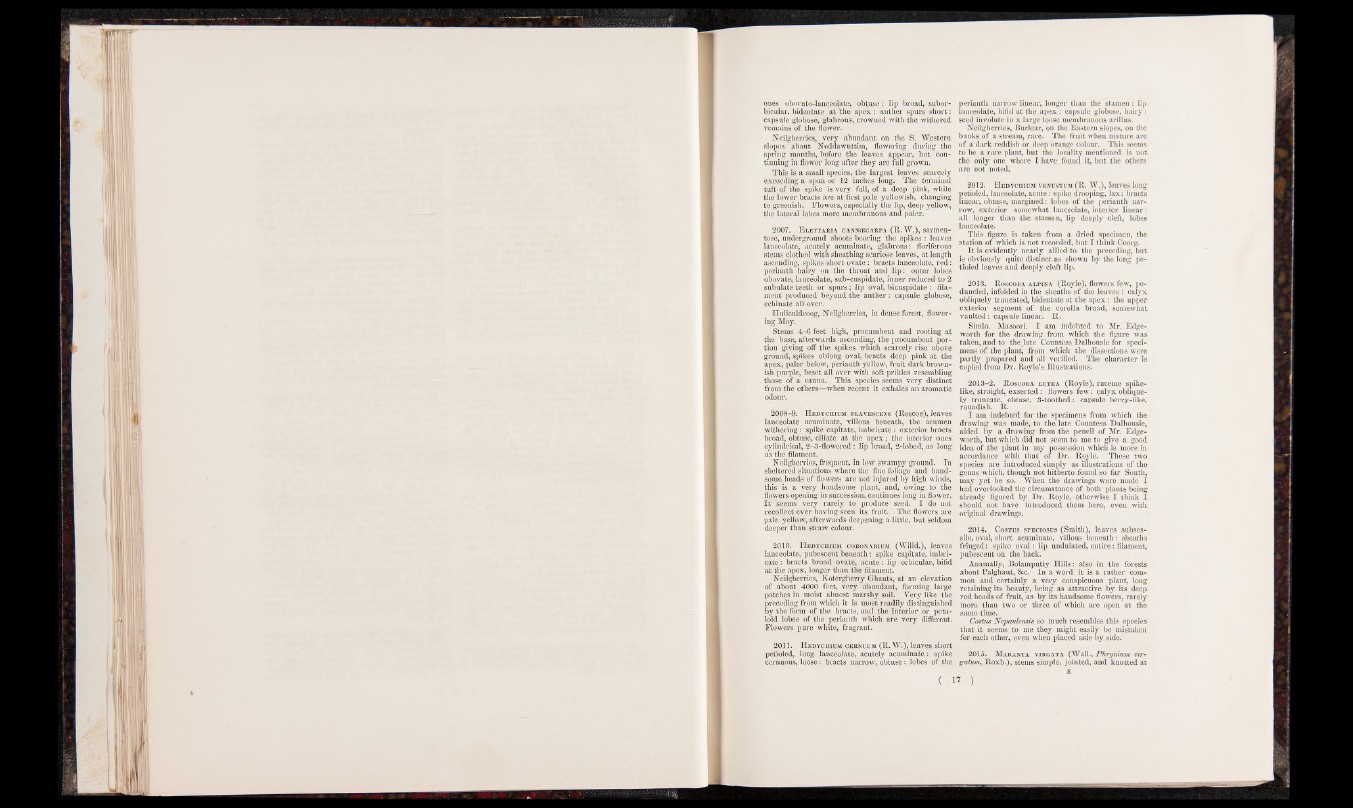
ones obovato-Ianceolate, obtuse: lip broad, subor-
bicular, bidentate at Nthe ap e x : anther spurs sh o rt:
capsule globose, glabrous, crowned with the withered
remains of the flower.
Neilgherries, very abundant on the S. Western
slopes about Neddawuttim, flowering during the
spring months, before the leaves appear, but continuing
in flower long after they are full grown.
This is a small species, the largest Leaves scarcely
exceeding a span or 12 inches long. The terminal
tuft of the spike is very full, of a deep pink, while
the lower bracts are at first pale yellowish, changing
to greenish. Flowers, especially the lip, deep yellow,
the lateral lobes more membranous and paler.
2007. E letxaria cannogcarpa (R.W.), sarmen-
tose, underground shoots bearing the spikes : leaves
lanceolate, acutely acuminate, glabrous: floriferous
stems clothed with sheathing scariose leaves, at length
ascending, spikes short ovate: bracts lanceolate, re d :
perianth hairy on the throat and lip: outer lobes
obovate, lanceolate, sub-cuspidate, inner reduced to 2
subulate teeth or spurs; lip oval, bicuspidate : filament
produced beyond the anthe r: capsule globose,
echinate all over.
Huliculdroog, Neilgherries, in dense forest, flowering
May.
Stems 4-6 feet high, procumbent and rooting at
the base, afterwards ascending, the procumbent portion
giving off the spikes which scarcely rise above
ground, spikes oblong oval, bracts deep pink at the
apex, paler below, perianth yellow, fruit dark brownish
purple, beset all over with soft prikles resembling
those of a canna. This species seems very distinct
from the others—when recent it exhales an aromatic
odour.
2008-9. H edychium feavescens (Roscoe), leaves
lanceolate acuminate, villous beneath, the acumen
withering: spike capitate, imbricate: exterior bracts
broad, obtuse, ciliate at the ap ex ; the interior ones
cylindrical, 2-3-flowered: lip broad, 2-lobed, as long
as the filament.
Neilgherries, frequent, in low swampy ground. In
sheltered situations where the fine foliage and handsome
heads of flowers are not injured by high winds,
this is a very handsome plant, and, owing to the
flowers opening in succession, continues long in flower.
I t seems very rarely to produce seed. I do not
recollect ever having seen its fruit. The' flowers are
pale yellow, afterwards deepening a little, but seldom
deeper than straw colour.
2010. H edychium coronarium (Willd.), leaves
lanceolate, pubescent beneath: spike capitate, imbricate
: bracts broad ovate, acute: lip orbicular, bifid
at the apex, longer than the filament.
Neilgherries, ICotergherry Ghauts, at an elevation
of about 4000 feet, very abundant, forming large
patches in moist almost marshy soil. Very like the
preceding from which it is most readily distinguished
by the form of the bracts, and the interior or peta-
loid lobes of the perianth which are very different.
Flowers pure white, fragrant.
2011. H edychium cernuum (R. W .), leaves short
petioled, long lanceolate, acutely acuminate: spike
cernuous, loose: bracts narrow, obtuse; lobes of the
perianth narrow linear, longer than the stamen: lip
lanceolate, bifid at the ap e x : capsule globose, hairy :
seed involute in a large loose membranous arillus.
Neilgherries, Burlear, on the Eastern slopes, on the
banks of a stream, rare. The fruit when mature are
of a dark reddish or deep orange colour. This seems
to be a rare plant, but the locality mentioned is not
the only one where I have found it, but the others
are not noted.
2012. H edychium venusxum (R. W.), leaves long
petioled, lanceolate, acute: spike drooping, lax; bracts
linear, obtuse, margined: lobes of the perianth narrow,
exterior somewhat lanceolate, interior linear :
all longer than the stamen, lip deeply cleft, lobes
lanceolate.
This figure is taken from a dried specimen, the
station of which is not recorded, but I think Coorg.
I t is evidently nearly allied to the preceding, but
is obviously quite distinct as shown by the long petioled
leaves and deeply cleft lip.
2013. R oscoe a alpina (Royle), flowers few, pe-
duncled, infolded in the sheaths of the leaves: calyx
obliquely truncated, bidentate at the ap ex : the upper
exterior segment of the corolla broad, somewhat
vaulted: capsule linear. R.
Simla. Masoori. I am indebted to Mr. Edge-
worth for the drawing from which the figure was
taken, and to the_late Countess Dalhousie for specimens
of the plan£ from which the dissections were
partly prepared and all verified. The character is
copied from Dr. Royle’s Illustrations.
2013-2. R oscoea lutea (Royle), raceme spikelike,
straight, exserted: flowers few: calyx obliquely
truncate, obtuse, 3-toothed: capsule berry-like,
roundish. R.
I am indebted for the specimens from which the
drawing was made, to the late Countess Dalhousie,
aided by a drawing from the pencil of Mr. Edge-
worth, but which did not seem to me to give a good
idea of the plant in my possession which is more in
accordance with that of Dr. Royle. These two
species are introduced simply as illustrations of the
genus which, though not hitherto found so far South,
may yet be so. When the drawings were made I
had overlooked the circumstance of both plants being
already figured by Dr. Royle, otherwise I think I
should not have introduced them here, even with
original drawings.
2014. Cosxus speciosus (Smith), leaves subses-
sile, oval, short acuminate, villous beneath: sheaths
fringed: spike oval: lip undulated, entire: filament,
pubescent on the back.
Anamally, Bolamputty Hills: also in the forests
about Palghaut, &c. In a word it is a rather common
and certainly a very conspicuous plant, long
retaining its beauty, being as attractive by its deep
red heads of fruit, as by its handsome flowers, rarely
more than two or three of which are open at the
same time.
Costus Nepaulensis so much resembles this species
that it seems to me they might easily be mistaken
for each other, even when placed side by side.
2015. Maranxa virgaxa (Wall., Phrynium vir-
gatmn, Roxb.), stems simple, jointed, and knotted at
E
m ■ )